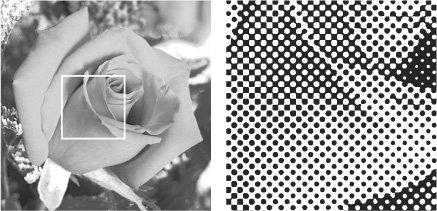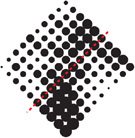Fundamentals of Black-and-White Printing
| The black in black-and-white printing is black ink. The white is the paper. When you hear a print job referred to as a two-color job, that means that two colors of ink will be required to print it. That may seem obvious, but here's a true story: There once was a poor, befuddled, novice print salesman who priced a black-and-white job as a two-color job: black and white. Understandably, he didn't last long in the trade and is probably selling used cars now. You may have heard the limerick:
Printing a single ink on paper is somewhat simpler than printing a four-color job, but the same rules apply. While a black-and-white photographic print or an image displayed on your monitor is made of a continuous range of thousands of shades of gray, a printing press doesn't print thousands of shades of ink. Instead, a single color of ink is printed in tiny dots called halftone dots, which simulate the shades of gray by varying the diameter of the dots (Figure 2.1). It's a convincing illusion because, unless your eyesight is very good, the individual dots are not apparent. An image printed by this method is also sometimes called a halftone. Figure 2.1. A black-and-white image looks smooth on your monitor. But it's actually printed with thousands of tiny halftone dots (right). Screen ruling (also called screen frequency) is the measure of halftone-dot frequency (Figure 2.2), usually expressed in lines per inch (lpi). Typical screen rulings range from 6585 lpi, used in newspapers, to 133150 lpi that is often used for magazines and books. Some high-end magazines and art books are printed at even higher line screensup to 200 or 300 lpi. The higher the screen ruling, the more faithfully images can be rendered, because finer detail can be maintained. So why wouldn't everything be printed at 300 lpi? Because printing conditions impose certain limitations. The coarse stock used for newspapers simply won't support fine line screens. Ink sinks into the absorbent stock and spreads, which is a phenomenon called dot gain. Try drawing small dots on a paper towel with a fine permanent marker, and you'll get an idea of the effect. The screen ruling is determined by the print service provider, based on the type of paper being used in the job. Figure 2.2. Screen ruling is measured in lines per inch (lpi). To better camouflage the rows of dots, they are printed at time-honored angles. For example, the dots in a black and white halftone image are usually printed at a 45 degree angle (Figure 2.3). You don't have to create the halftone dots or figure out the appropriate angle for them. Those attributes are determined by the print service provider. The halftone dots don't come into being until the job is processed by the raster image processor (RIP). Figure 2.3. Screen angle: 45° If screen angles and screen frequency are the print service provider's problem, why should designers and production artists even care about such issues? Because it's helpful to have realistic expectations of the printed outcome, and both screen angle and screen ruling have an impact on printed work. Highly patterned image content, such as woven fabric, can result in an unpleasant moiré when the patterns imposed by image resolution, line screen, and screen angle combine to generate the final product. Scanning at very high resolutions may help in some instances, but it will also produce large image files. Blurring the troublesome content may help, but is sometimes undesirable ("I thought this was a tweed jacket. It looks like velveteen."). Changing the screen ruling or screen angles may reduce moiré in one part of the image, but increase the effect in another area.
|
EAN: 2147483647
Pages: 132


